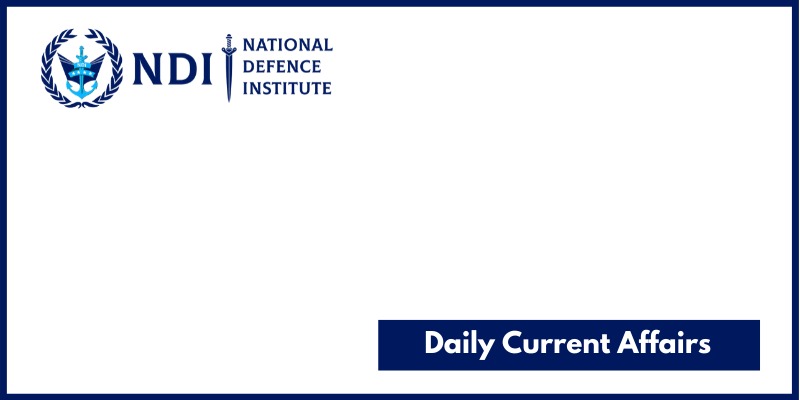1. Hwasong-20
North Korea recently unveiled its most powerful intercontinental ballistic missile, Hwasong-20, during a military parade led by Kim Jong Un.
The solid-fuel ICBM, made of carbon-fiber composites, can be moved and launched quickly, making it harder to intercept. It has a range of over 15,000 km and features an advanced guidance system combining inertial navigation with GPS or optical sensors.
An Intercontinental Ballistic Missile (ICBM) is a nuclear-capable missile with a range exceeding 5,600 km. It can be launched from silos, mobile launchers, or submarines.
Countries with operational ICBMs include Russia, the U.S., China, France, India, the U.K., Israel, and North Korea.
2. Palau
Palau recently hosted the world’s first-ever live underwater interview to promote ocean awareness.
Located in the western Pacific Ocean, Palau is an archipelago of about 300 islands covering 458 sq. km.
Its capital, Ngerulmud, is the world’s least populous capital, while Koror is the largest city.
Languages spoken include Palauan, English, Japanese, Sonsorolese, and Tobian.
Independent since 1994, Palau maintains defense ties and financial support from the United States under the Compact of Free Association.
3. Qubit
Researchers at Caltech have created the world’s largest neutral-atom qubit array of 6,100 qubits, advancing quantum computing.
A qubit (quantum bit) is the fundamental unit of quantum information, capable of existing in a superposition of 0 and 1 states simultaneously.
This property enables quantum computers to process vast amounts of data much faster than classical systems.
Qubits are created using photons, electrons, ions, or superconducting circuits, and the term was coined by physicist Benjamin Schumacher.
4. Pradhan Mantri Dhan-Dhaanya Krishi Yojana (PMDDKY)
The government launched PMDDKY and the Mission for Aatmanirbharta in Pulses with a total outlay of ₹35,440 crore.
PMDDKY consolidates 36 agricultural schemes under 11 ministries to assist 1.7 crore small and marginal farmers in 100 low-performing districts.
It aims to improve crop yields, irrigation, storage, and market access, while promoting sustainable and organic farming.
Key goals include raising crop productivity by 20–30%, enhancing irrigation coverage, and doubling farmer incomes by 2030.
5. Keratoconus
A recent study found that keratoconus, a progressive eye disorder, can worsen even after treatment.
It occurs when the cornea becomes thin and cone-shaped, distorting vision.
It usually develops in the late teens or early 20s and can affect both eyes differently.
While early stages are treated with glasses or lenses, advanced cases may need corneal transplantation.
Corneal collagen cross-linking can slow or halt progression but cannot reverse the damage.
6. Sugamya Bharat App
The government launched a revamped Sugamya Bharat App under the Accessible India Campaign to improve accessibility for persons with disabilities and the elderly.
The app features AI chatbot support, grievance redressal, and accessibility mapping for public spaces.
It offers information on government schemes, jobs, and education opportunities, and supports 10 Indian languages.
Developed by the Department of Empowerment of Persons with Disabilities (DEPwD), it aims to create an inclusive and barrier-free India.
7. Siddi Tribal Community
President Droupadi Murmu lauded the Siddi tribal community, a Particularly Vulnerable Tribal Group (PVTG), for achieving over 72% literacy.
Descended from the Bantu people of Africa, Siddis arrived in India via Arab traders and European colonizers.
They primarily live in Gujarat, Maharashtra, Karnataka, and Telangana, engaging in agriculture and manual labor.
Known for their vibrant Dhamal and Rasda dances, they were recognized as a Scheduled Tribe in 2003.
8. Bharat Taxi Initiative
The Bharat Taxi Initiative, led by NeGD and Sahakar Taxi Cooperative, is a cooperative-driven national ride-hailing platform promoting inclusive digital services.
Supported by cooperatives like AMUL, IFFCO, NAFED, and NABARD, it integrates with DigiLocker, UMANG, and API Setu for seamless user experience.
It aligns with the Digital India mission, emphasizing security, accessibility, and multilingual design.
The platform will officially launch in December 2025.
9. Green Sea Turtle
The green sea turtle (Chelonia mydas) has moved from Endangered to Least Concern on the IUCN Red List, showing major conservation success.
These are the largest hard-shelled sea turtles, named for the green fat beneath their shell.
Found in tropical and subtropical oceans, they are vital to marine ecosystems as grazers of seagrass beds.
They can live up to 70 years and are protected under global marine conservation programs.
10. Research Development and Innovation (RDI) Scheme
The Anusandhan National Research Foundation (ANRF) approved a ₹1 lakh crore fund for the RDI Scheme to boost private investment in research and innovation.
It aims to promote deep-tech, strategic technologies, and high-TRL projects through long-term low-interest loans and equity funding.
Governed by a board chaired by the Prime Minister, it will channel funds through alternative investment funds and NBFCs to support India’s R&D ecosystem.


























































































































































.png)
.png)
.png)
.png)
.png)


.png)
.png)
.png)





.png)
.png)






.png)
.png)
.png)
.png)
.png)
.png)
.png)
.png)
.png)

.png)







.png)
.png)


.png)
.png)
.png)


.png)

.png)
.png)





.jpg)

.png)
.png)


.png)

.png)
.png)
.png)

.jpg)

.jpg)


.png)

.png)
.png)
.png)
.png)
.png)
.png)
.png)
.png)
.png)
.png)




.png)

.png)





.png)
.png)
.png)
.png)
.png)
.png)
.png)
.png)
.png)
.png)
.jpg)
.jpg)

.png)
.png)
.png)
.png)
.png)
.png)
.png)
.png)
.png)
.png)
.png)
.png)
.png)
.png)
.png)
.png)
.png)
.png)
.png)
.png)
.png)
.png)



.png)
.png)

.jpg)
.jpg)


.jpg)
.jpg)
.jpg)
.jpg)
.jpg)

.jpg)








.jpg)
.jpg)
.jpg)
.jpg)
.jpg)

















.jpg)
.jpg)







.jpg)


















.jpg)
.jpg)






























































































.jpg)
.jpg)


























.jpg)

.jpg)










.jpg)








.jpg)




.jpg)










.jpg)


















.jpg)












































.jpg)














.jpg)
.jpg)
.jpg)





.jpg)

.jpg)
.jpg)





































































.jpg)


































.jpg)
.jpg)
















































.jpg)












.jpg)


.jpg)




.jpg)
.jpg)
.jpg)

.jpg)
.jpg)
.jpg)
.jpg)

.jpg)
.jpg)
.jpg)

.jpg)
.jpg)
.jpg)
.jpg)
.jpg)
.jpg)
.jpg)
.jpg)

.jpg)


.jpg)
.jpg)
.jpg)
.jpg)
.jpg)
.jpg)
.jpg)
.jpg)
.jpg)
.jpg)











.jpg)
.jpg)





.jpg)
.jpg)
.jpg)
























.jpg)
























.jpg)









.jpg)
.jpg)







.jpg)
.jpg)









































.jpg)
.jpg)
.jpg)
.jpg)
.jpg)

.jpg)
.jpg)
.jpg)
.jpg)
.jpg)


.jpg)
.jpg)
.jpg)
.jpg)
.jpg)

.jpg)
.jpg)
.jpg)
.jpg)
.jpg)
.jpg)
.jpg)
.jpg)
.jpg)
.jpg)
.png)

.png)
.png)

.png)
.png)
.png)
.png)


.jpg)
.jpg)

.jpg)
.jpg)
.jpg)

.png)
.png)
.png)
.png)
.png)
.png)
.png)

.png)
.png)
.png)
.png)
.png)
.png)
.png)
.png)
.png)
.png)





































































-min.png)



.png)




.png)








































